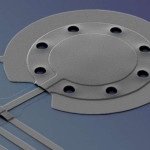
WHY THIS MATTERS IN BRIEF
Scientists have chilled a complex object to almost absolute zero and it could herald breakthroughs in sensor technology, quantum computing and… yes, even teleportation.
Nothing can be chilled below absolute zero, or −273.15°C, because at this temperature all molecular motion stops completely. Per Heisenberg’s uncertainty principle the forces of real particle velocities will always be above zero. It’s a fundamental limit that can’t seem to be broken, and that’s fine, but what bothers scientists, however, are other limits that keep them from cooling things near absolute zero.
For decades, researchers have used lasers to cool down atoms very close to absolute zero. However, when you try to cool close to zero something macroscopically, like a power cable or even a coin, you get hit by a brick wall – a ‘quantum limit’ that keeps mechanical objects from getting too cold.
Researchers have tried for decades to reach absolute zero but now the scientists at the National Institutes of Standards (NIST) have cooled an aluminum drum to 360 microKelvin,−273.16°C, or, put another way 10,000 times colder than the vacuum of space – or as cold as London in January. They published their findings Nature.
“The results were a complete surprise to experts in the field,” said José Aumentado, co-author of the paper, “it’s a very elegant experiment that will certainly have a lot of impact.”
While scientists had previously brought individual atoms to absolute zero this is the first time a scientists have managed to chill a complex object – and the details are pretty technical. In the paper Kaplan explains how his team used a process called sideband cooling, where researchers used lasers to frost over a tiny aluminum drum, just 20 micrometers across and 100 nanometers thick.
“This may seem counterintuitive,” Kaplan writes, “we’re used to light warming things up, like the sun, but in sideband cooling the carefully calibrated angle and frequency of the light allows photons to snatch energy from the atoms as they interact.”
Using this method, researchers had previously reduced the motion of the drum to what’s known as quantum “ground state” -which is just one-third of a quantum of energy, but Kaplan had an inkling it could get colder.
“The limit of how cold you can make things by shining light on them was the bottleneck that was keeping people from getting colder and colder,” said Kaplan, “the question was, is it fundamental or could we actually get colder?”
Though the lasers cooled the object, some noise in the lasers provided tiny “kicks” of heat so Kaplan and his colleagues “squeezed” the light, lining the tiny packets of energy in the laser up even tighter to cool the drum without adding energy back into the system. This allowed them to cool the drum to one fifth of a quantum, and they believe that with further refinements this system might enable them to cool the drum to absolute zero.
Such extreme cooling is not just a parlor trick. It has real world applications, too.
“The colder you can get the drum, the better it is for any application,” says Kaplan, “sensors would become more sensitive. You can store information longer. If you were using it in a quantum computer, then you would compute without distortion, and you would actually get the answer you want.”
Cooling the drum could also help scientists observe some of the mysteries of quantum mechanics first hand.
“I think we’re in an extremely exciting time where this technology we have available gives us access to things people have been talking about as thought experiments for decades, just now what’s exciting is we can go into the laboratory and actually witness these quantum effects,” says Kaplan.
Meanwhile cooling the drum to absolute zero, in which only quantum energy remains, would allow scientists to observe some of the weirder aspects of quantum theory. For instance, the drum, if it were scaled up, could be used to teleport visible objects. The research could also help researchers bridge the gap of understand between the point at which quantum physics, which governs very small particles, seems to stop working and more classical physics, governing large objects like stars and planets, begins to take over.


















[…] Source link […]